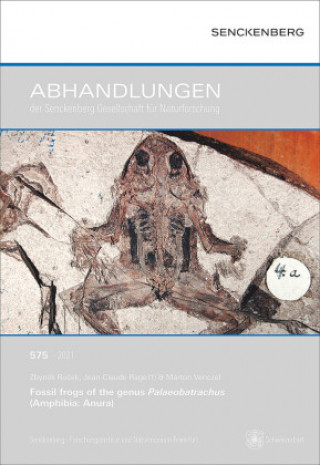
Kód: 35814728
Fossil frogs of the genus Palaeobatrachus (Amphibia: Anura)
Autor Jean-Claude Rage, Márton Venczel
Palaeobatrachidae are an extinct family of frogs whose earliest members are recorded from the Middle Eocene (Geiseltal, Messel, Germany), almost 50 million years ago, although there are indications that they appeared as early as b ... celý popis
- Jazyk:
 Angličtina
Angličtina - Vazba: Brožovaná
- Počet stran: 151
Nakladatelství: Schweizerbart Sche Vlgsb., 2021
- Více informací o knize

Mohlo by se vám také líbit
Dárkový poukaz: Radost zaručena
- Darujte poukaz v libovolné hodnotě a my se postaráme o zbytek.
- Poukaz se vztahuje na celou naši nabídku.
- Elektronický poukaz vytisknete z e-mailu a můžete ihned darovat.
- Platnost poukazu je 12 měsíců od data vystavení.
Více informací o knize Fossil frogs of the genus Palaeobatrachus (Amphibia: Anura)
Nákupem získáte 93 bodů
 Anotace knihy
Anotace knihy
Palaeobatrachidae are an extinct family of frogs whose earliest members are recorded from the Middle Eocene (Geiseltal, Messel, Germany), almost 50 million years ago, although there are indications that they appeared as early as before the Cretaceous mass extinction event and survived almost to our times. Their last survivors are recorded from the Middle Pleistocene, less than 0.5 million years ago, such that they were contemporaries of Neanderthal man. Their last fossil evidence is from the regions that were adjacent to the Pleistocene continental glacier. Like today s pipid frogs (e.g. Xenopus), they were obligate water dwellers, not able to make long excursions onto dry land. Without exaggerating, they literally died out frozen in their ponds. Permanent life in water has a uniforming effect. This is why they all looked similar to one another, which is a source of difficulty for taxonomists. On the other hand, one cannot overlook features they have in common with pipids, restricted to the southern hemisphere. Palaeobatrachus and Xenopus are undoubtedly related, but when and why ancestors of Palaeobatrachus immigrated to the western part of northern Eurasia but not to its eastern part and not to North America remains a puzzling question. Thus, being acquainted with Palaeobatrachus means to be invited on an excursion not only into comparative anatomy, but also into paleogeography and many other fields of palaeontology. Last but not least, Palaeobatrachus was the first fossil frog scientifically described, as early as in 1831. Since that time, many excavation sites from which original material came have ceased to exist; thus there is no possibility that further material will be recovered. What is now deposited in scientific collections is the unique and limited source of data for future comparative studies. This is one of the main reasons why this rich illustrated review was published.
 Parametry knihy
Parametry knihy
933 Kč
- Plný název: Fossil frogs of the genus Palaeobatrachus (Amphibia: Anura)
- Autor: Jean-Claude Rage, Márton Venczel
- Jazyk:
 Angličtina
Angličtina - Vazba: Brožovaná
- Počet stran: 151
- EAN: 9783510614202
- ISBN: 3510614208
- ID: 35814728
- Nakladatelství: Schweizerbart Sche Vlgsb.
- Hmotnost: 690 g
- Rozměry: 294 × 208 × 12 mm
- Datum vydání: 03. May 2021
Oblíbené z jiného soudku
-

Dune
217 Kč -

Haunting Adeline
620 Kč -

Berserk Deluxe Volume 2
1092 Kč -

White Nights
90 Kč -

Powerless
291 Kč -

Atomic Habits
509 Kč -

Dune Messiah
228 Kč -

Berserk Deluxe Volume 3
1142 Kč -

One Day
218 Kč -

Berserk Deluxe Volume 1
1115 Kč -

Iron Flame
354 Kč -

Surrounded by Idiots
303 Kč -

Harry Potter and the Prisoner of Azkaban (Minalima Edition)
993 Kč -

Gravity Falls Journal 3
440 Kč -

Heaven Official's Blessing: Tian Guan Ci Fu (Novel) Vol. 1
440 Kč -

The Creative Act
550 Kč -

Dune
204 Kč -

Hunting Adeline
642 Kč -

A Little Life
267 Kč -

Children of Dune
230 Kč -

Heaven Official's Blessing: Tian Guan Ci Fu (Novel) Vol. 2
479 Kč -

Bungo Stray Dogs, Vol. 8 (light novel)
404 Kč -

Percy Jackson and the Olympians 5 Book Paperback Boxed Set
953 Kč -

Solo Leveling, Vol. 1
443 Kč -

The Prisoner's Throne
268 Kč -

Court of Thorns and Roses
268 Kč -

Cry Baby Coloring Book
281 Kč -

Fourth Wing
353 Kč -

Icebreaker
199 Kč -

Berserk Deluxe Volume 6
1089 Kč -

Avatar, the Last Airbender: The Kyoshi Novels (Box Set)
833 Kč -

The 48 Laws of Power
601 Kč -

House of Leaves
462 Kč -

Twisted Lies
213 Kč -

Dune Messiah
277 Kč -

No Longer Human
339 Kč -

48 Laws Of Power
531 Kč -

Twisted Games
291 Kč -

Caraval Paperback Boxed Set
905 Kč -

Solo Leveling, Vol. 2
351 Kč -

Open Circuits
910 Kč -

Berserk Deluxe Volume 5
1119 Kč -

Heaven Official's Blessing: Tian Guan Ci Fu (Novel) Vol. 3
410 Kč -

Berserk Deluxe Volume 4
1292 Kč -

Court of Mist and Fury
268 Kč -

SOLO LEVELING V08
436 Kč -

English File Upper Intermediate Multipack A (4th)
487 Kč -

CHAINSAW MAN V14
253 Kč -

Before the Coffee Gets Cold
251 Kč
Osobní odběr Praha, Brno a 12903 dalších
Copyright ©2008-24 nejlevnejsi-knihy.cz Všechna práva vyhrazenaSoukromíCookies









 Vrácení do měsíce
Vrácení do měsíce 571 999 099 (8-15.30h)
571 999 099 (8-15.30h)